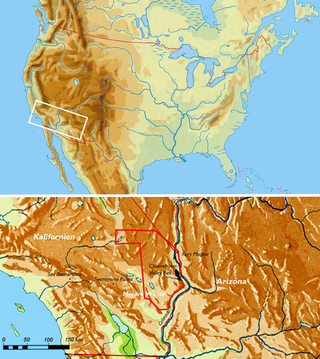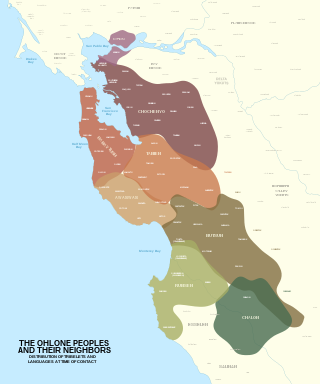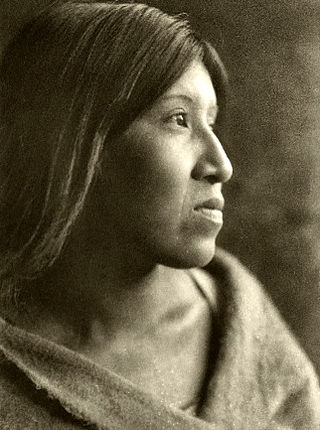
The Klamath people are a Native American tribe of the Plateau culture area in Southern Oregon and Northern California. Today Klamath people are enrolled in the federally recognized tribes:

Mohave or Mojave are a Native American people indigenous to the Colorado River in the Mojave Desert. The Fort Mojave Indian Reservation includes territory within the borders of California, Arizona, and Nevada. The Colorado River Indian Reservation includes parts of California and Arizona and is shared by members of the Chemehuevi, Hopi, and Navajo peoples.

The Chemehuevi are an indigenous people of the Great Basin. They are the southernmost branch of Southern Paiute. Today, Chemehuevi people are enrolled in the following federally recognized tribes:

The Mojave River is an intermittent river in the eastern San Bernardino Mountains and the Mojave Desert in San Bernardino County, California, United States. Most of its flow is underground, while its surface channels remain dry most of the time, except for the headwaters and several bedrock gorges in the lower reaches.

The Ohlone, formerly known as Costanoans, are a Native American people of the Northern California coast. When Spanish explorers and missionaries arrived in the late 18th century, the Ohlone inhabited the area along the coast from San Francisco Bay through Monterey Bay to the lower Salinas Valley. At that time they spoke a variety of related languages. The Ohlone languages make up a sub-family of the Utian language family. Older proposals place Utian within the Penutian language phylum, while newer proposals group it as Yok-Utian.

The Cahuilla, also known as ʔívil̃uqaletem or Ivilyuqaletem, are a Native American people of the various tribes of the Cahuilla Nation, living in the inland areas of southern California. Their original territory encompassed about 2,400 square miles (6,200 km2). The traditional Cahuilla territory was near the geographic center of Southern California. It was bounded to the north by the San Bernardino Mountains, to the south by Borrego Springs and the Chocolate Mountains, to the east by the Colorado Desert, and to the west by the San Jacinto Plain and the eastern slopes of the Palomar Mountains.

Chumashan is an extinct and revitalizing family of languages that were spoken on the southern California coast by Native American Chumash people, from the Coastal plains and valleys of San Luis Obispo to Malibu, neighboring inland and Transverse Ranges valleys and canyons east to bordering the San Joaquin Valley, to three adjacent Channel Islands: San Miguel, Santa Rosa, and Santa Cruz.

The Kawaiisu Nation are a tribe of indigenous people of California in the United States. The Kawaiisu Nation is the only treatied tribe in California, Ratified Treaty, 9 Stat. 984, Dec. 30, 1849. This Treaty with the Utah Confederation of tribal nations. They have never given up their territorial rights to any of their ancestral land to the United States. The Kawaiisu Nation had preexisting treaties with Spain and those were recognized by Mexico until 1849 when California was becoming a State.

Serrano is a language in the Serran branch of the Uto-Aztecan family spoken by the Serrano people of Southern California. The language is closely related to Tongva, Tataviam, Kitanemuk and Vanyume, which may be a dialect of Serrano. Serrano has free word order with the only rule being that verbs usually come last.
The Kitanemuk are an Indigenous people of California and were a tribal village of the Kawaiisu Nation.The Kawaiisu traditionally lived in the Tehachapi Mountains and the Antelope Valley area of the western Mojave Desert of southern California, United States which has historically has been within the territory of the Kawaiisu. Today some of these members people are enrolled in the federally recognized Tejon Indian Tribe of California.

The Tübatulabal are an indigenous people of Kern River Valley in the Sierra Nevada range of California. They may have been the first people to make this area their permanent home. Today many of them are enrolled in the Tule River Indian Tribe. They are descendants of the people of the Uto-Aztecan language group, separating from Shoshone people about 3000 years ago.

The Serrano are an Indigenous people of California. Their autonyms are Taaqtam meaning "people", Maarrênga’yam meaning "people from Morongo", and Yuhaaviatam meaning "people of the pines."

The Tataviam language was spoken by the Tataviam people of the upper Santa Clara River basin, Santa Susana Mountains, and Sierra Pelona Mountains in southern California. It had become extinct by 1916 and is known only from a few early records, notably a few words recorded by Alfred L. Kroeber and John P. Harrington in the early decades of the 20th century. These word lists were not from native speakers, but from the children of the last speakers who remembered a few words and phrases.

The Tataviam are a Native American group in Southern California. The ancestral land of the Tataviam people includes northwest present-day Los Angeles County and southern Ventura County, primarily in the upper basin of the Santa Clara River, the Santa Susana Mountains, and the Sierra Pelona Mountains. They are distinct from the Kitanemuk and the Gabrielino-Tongva peoples.
Kitanemuk traditional narratives include myths, legends, tales, and oral histories preserved by the Kitanemuk people of the Tehachapi Mountains, southern Sierra Nevada, and the western Mojave Desert of southern California.

The Takic languages are a putative group of Uto-Aztecan languages historically spoken by a number of Indigenous peoples of Southern California. Takic is grouped with the Tubatulabal, Hopi, and Numic languages in the northern branch of the Uto-Aztecan family.
Tamcan or Tammukan was a local tribe of Delta Yokuts-speaking natives in the U.S. that once lived on the lower reaches of California's San Joaquin River in what is now eastern Contra Costa County and western San Joaquin County, California. The Tamcans were absorbed into the system of the Spanish missions in California in the early nineteenth century; they moved to Mission San José, near the shore of San Francisco Bay, between 1806 and 1811. At the mission, they and their descendants intermarried with speakers of the San Francisco Bay Ohlone, Plains Miwok, and Patwin Indian languages. Mission Indian survivors of these mixed groups gathered at Alisal, near Pleasanton in Contra Costa County, in the late nineteenth century.

Irataba was a leader of the Mohave Nation, known as a mediator between the Mohave and the United States. He was born near the Colorado River in present-day Arizona. Irataba was a renowned orator and one of the first Mohave to speak English, a skill he used to develop relations with the United States.
Kizh, or Kit’c, are the Mission Indians of San Gabriel, an Indigenous peoples of California. They belong to a group commonly known by the Spanish name, Gabrieleño.

Wáꞌpeat was a major village populated by the Serrano or Vanyume, closest situated to what is now Hesperia and Crestline, and within the vicinity of Cajon Pass and Silverwood Lake, California. The village name was derived from waꞌat, or the Serrano word for juniper, which grew abundantly in the area. Wáꞌpeat had deep ties with other villages along the Mojave River and the southern Antelope Valley and was the site of community gatherings.














